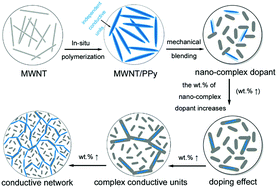Conductive properties and mechanism of polyvinyl chloride doped by a multi-walled carbon nanotube–polypyrrole nano-complex dopant
Abstract
In situ polymerization and mechanical blending were utilized to fabricate a multi-walled carbon nanotube–polypyrrole (MWNT–PPy) nano-complex dopant for a polyvinyl chloride (PVC) matrix. A low percolation threshold in PVC for this nano-complex dopant was found. A few percent of doping sharply increases the electrical conductivity of PVC. Further doping with this nano-complex dopant still can enhance the conductivity of PVC but with a much slower rate. Based on our experimental results we propose a mechanism to explain the observed phenomenon: the complex conductive units are formed in the nano-complex dopants due to the interaction of MWNT and PPy, with conductivity close to the intrinsic conductivity of MWNT which is much higher than that of PPy. The conductivity increases significantly with a few percent of dopant. The reason is that the interaction of components becomes stronger with continuous doping, forming relatively independent conductive units. The strong doping effect makes the carrier concentration of the units increase significantly so that the conductivity grows, playing a main role in the conductive system of the composite. After the conductivity curve passes the inflection point, further doping can still enhance the conductivity but with a much slower rate. In this phase, the electron delocalization range extends; complex conductive units interconnect and generate the conductive networks; the conjugate degree of the composite increases; the large π conjugated system is built; the carrier mobility increases as well as the conductivity.


 Please wait while we load your content...
Please wait while we load your content...